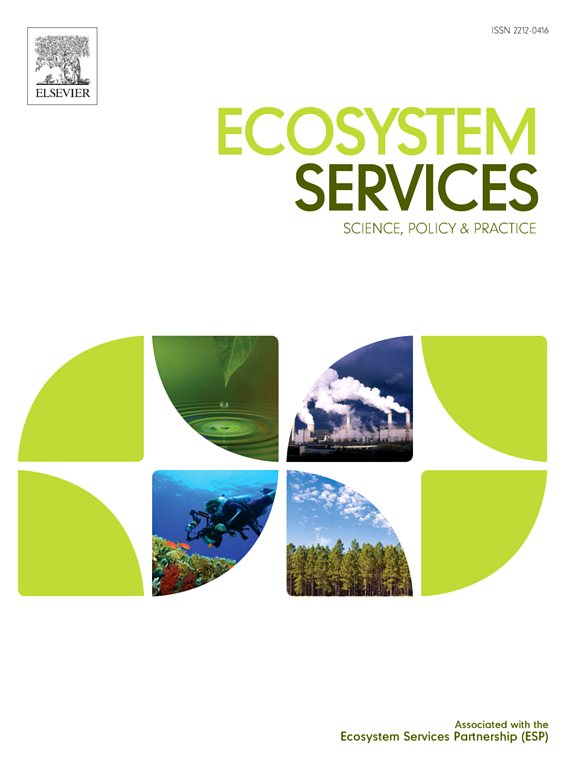Revealing driver-mediated indirect interactions between ecosystem services using Bayesian Belief Networks
IF 6.6
2区 环境科学与生态学
Q1 ECOLOGY
引用次数: 0
Abstract
Understanding the drivers mediating ecosystem service interactions is essential for supporting policy decisions aimed at sustaining synergies and mitigating trade-offs. Currently, most studies assessing ecosystem service interactions do not model them as a causal network. Here, we use Bayesian Belief Networks (BBNs) to assess how human activity intensity influences ecosystem service interactions (e.g., trade-off, synergy, no effect). We quantify changes in interactions for two snapshots in time in Southern Quebec (Canada) among aboveground forest carbon regulation, maple syrup provisioning, livestock provisioning, landscape recreation, bird-watching recreation, and number of bird species per route (an Essential Biodiversity Variable). By comparing correlation analyses to BBNs with or without the driver of human activity intensity, we show that not accounting for human activity intensity results in incorrectly attributing a driver-mediated trade-off as a direct trade-off (e.g., between bird-watching recreation and aboveground forest carbon regulation) and failure to detect direct interactions (e.g., between bird-watching recreation and livestock provisioning). BBNs provide a more complete understanding of interactions. In contrast to correlation analysis, which can only assess a relationship between two variables, BBNs can assess relationships among multiple variables and as such determine whether a relationship is due to a shared driver or whether the relationship is due to a direct synergy or trade-off among services. However, if relevant drivers are excluded, then direct interactions may be missed, and driver-mediated relationships may be incorrectly attributed as direct interactions. A better understanding of drivers that shape ecosystem service interactions could guide their management and provide targeted policy interventions.

利用贝叶斯信念网络揭示生态系统服务之间驱动介导的间接相互作用
了解调节生态系统服务相互作用的驱动因素对于支持旨在维持协同效应和减轻权衡的政策决策至关重要。目前,大多数评估生态系统服务相互作用的研究都没有将它们建模为因果网络。在这里,我们使用贝叶斯信念网络(bbn)来评估人类活动强度如何影响生态系统服务相互作用(例如,权衡,协同,无影响)。我们量化了南魁北克(加拿大)地上森林碳调节、枫糖浆供应、牲畜供应、景观休闲、观鸟休闲和每条路线鸟类物种数量(一个基本生物多样性变量)之间的相互作用变化。通过比较有或没有人类活动强度驱动因素的bbn的相关性分析,我们发现,不考虑人类活动强度会导致将驱动因素介导的权衡错误地归结为直接权衡(例如,观鸟娱乐和地上森林碳调节之间的权衡),而无法发现直接相互作用(例如,观鸟娱乐和牲畜供应之间的相互作用)。bbn提供了对相互作用更完整的理解。与只能评估两个变量之间关系的相关分析不同,bbn可以评估多个变量之间的关系,从而确定一种关系是由于共享驱动因素,还是由于服务之间的直接协同或权衡。然而,如果排除相关的驱动因素,那么直接的相互作用可能会被遗漏,并且驱动因素介导的关系可能被错误地归因于直接的相互作用。更好地了解形成生态系统服务相互作用的驱动因素可以指导其管理并提供有针对性的政策干预。
本文章由计算机程序翻译,如有差异,请以英文原文为准。
求助全文
约1分钟内获得全文
求助全文
来源期刊

Ecosystem Services
ECOLOGYENVIRONMENTAL SCIENCES&-ENVIRONMENTAL SCIENCES
CiteScore
14.90
自引率
7.90%
发文量
109
期刊介绍:
Ecosystem Services is an international, interdisciplinary journal that is associated with the Ecosystem Services Partnership (ESP). The journal is dedicated to exploring the science, policy, and practice related to ecosystem services, which are the various ways in which ecosystems contribute to human well-being, both directly and indirectly.
Ecosystem Services contributes to the broader goal of ensuring that the benefits of ecosystems are recognized, valued, and sustainably managed for the well-being of current and future generations. The journal serves as a platform for scholars, practitioners, policymakers, and other stakeholders to share their findings and insights, fostering collaboration and innovation in the field of ecosystem services.
 求助内容:
求助内容: 应助结果提醒方式:
应助结果提醒方式:


